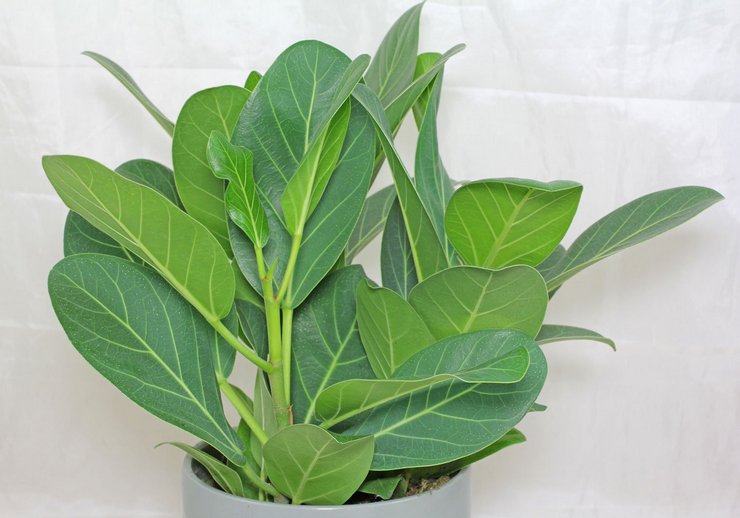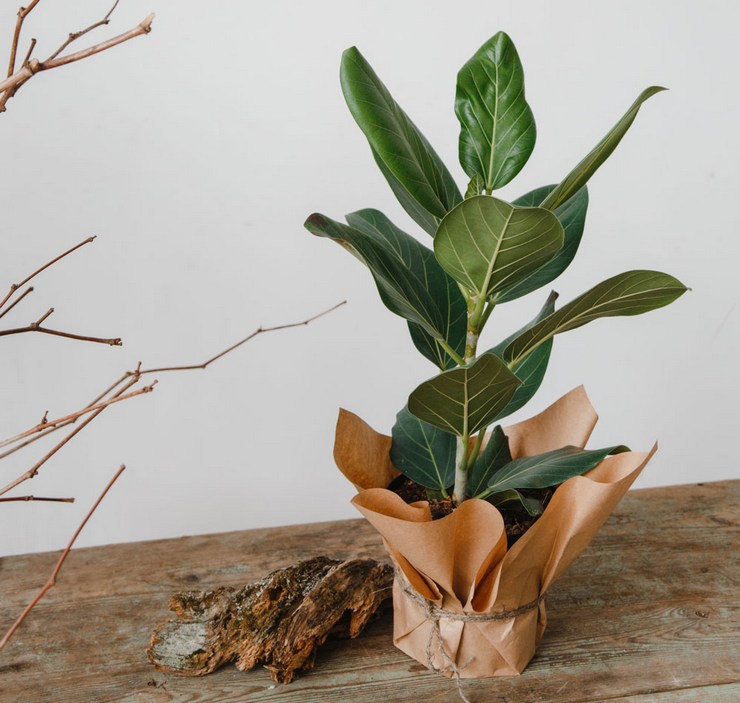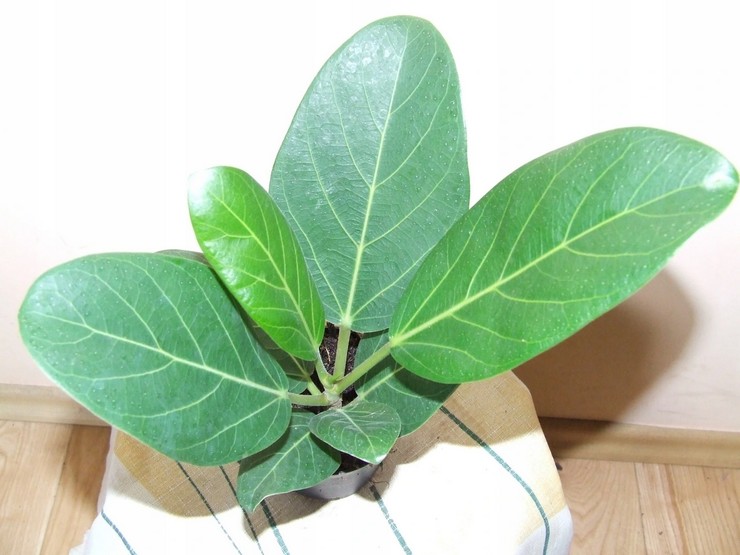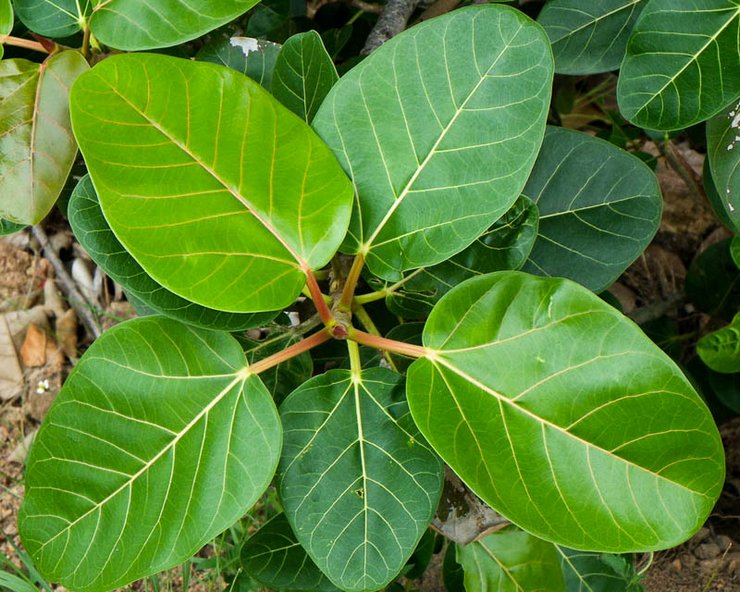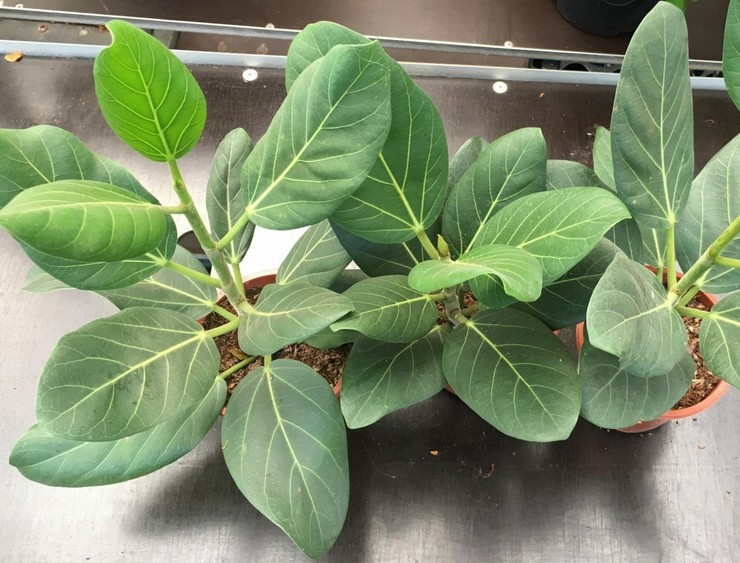Bengal ficus (Ficus benghalensis) belongs to the genus Ficus, which belongs to mulberry evergreens. The culture is often found in the humid climates of the mountainous regions of Asia. Wild plantings of this species can be seen in Malaysia, Burma, India and Thailand..
Ficus Bengal has the unique ability to transform from one tree into a whole forest. This is due to the fact that all plants are located tightly to each other and form solid deciduous thickets. Scientists called this form of growth a banyan tree. The process begins with the formation of thick aerial roots. They are on the surface of the horizontal branches. Some of the roots dry up, and the rest rest against the soil. Over time, rooting and desalinization of root processes is observed..
Perennial trees, adapted to grow in their natural environment, have roots similar to bearing trunks. Secondary shoots extend from the sides in different directions in parallel. The described life form of growth allows the ficus to grow widely, covering a huge space in a short time and forming a lush, impenetrable grove with a unique ecosystem.
Of course, Bengal ficus is not the only one of its kind that is capable of building a banyan tree. There are many other woody species. Despite this, the culture in question is considered the most powerful representative among the family.
Without human intervention, ficus trees reach almost forty meters in height. Large leaf blades lengthen up to 25 cm. The foliage looks varied. Bred ficuses with oval, simple and ovoid leaves. Leathery plates are covered with light green veins. The inflorescences are small, orange, spherical fruits that are unique to this species. The size of the flowers is about 2-3 cm.
Varieties with variegated bright foliage are in demand among many growers engaged in the breeding of cultural perennials..
Caring for ficus Bengal at home
To grow a healthy and attractive ficus tree, before buying a seedling, it is better to think in advance about whether your apartment or office meets the conditions of maintenance. The main requirement is the availability of free space, since the tree grows up to 3 m in height. For normal development, the perennial is placed in a spacious room. Caring for Bengal ficus has a lot in common with other types of mulberry plants. Let’s dwell on the most important factors for successful crop cultivation.
Location and lighting
The need for light in ficus is rather weak, but this does not mean that the flowerpot is placed in the shade, where there are no window openings. On the contrary, the optimal location is a bright, spacious room, in which the illumination indicators are equal to 2600-3000 lumens. Stable development can also be achieved with artificial light.
To form a uniform crown, the flower pot is periodically turned clockwise.
Temperature
A flowerpot with a tree is stored in a room with a moderate temperature of 18-26 ° C all year round. The plant does not tolerate drafts, it reacts especially sharply when the temperature drops below 17 ° C. In response to unfavorable conditions, the ficus is able to shed its leaves..
Watering features
The described culture is going through a period of dormancy. The intervals between waterings in winter and summer are the same. The signal for the next moistening is the formation of a dry crust on the surface of the substrate. The soil is watered only on condition that the earth has dried out by 2-3 cm.
Air humidity
Given the fact that the tree is large, spraying the foliage will take a long time and will not lead to the desired result. Instead, it is recommended to wipe the dust off the leaves using a soft cloth dampened with water. This moisturizing and cleansing will be much more beneficial than spraying, and will avoid the accumulation of dirt..
As the heating devices turn on, the flowerpot is set aside, otherwise the dry air that the heating elements produce will provoke dry leaves. When organizing the rearrangement, it should be taken into account that the illumination level does not change..
The soil
A neutral or slightly acidic soil of a dense consistency, rich in nutrients, is poured into the pot. The soil for planting is bought either in a specialized store, or collected by hand. For these purposes, you need to mix an equal amount of leaf, turf, peat land and add sand. At the bottom of the flowerpot leave a place for laying drainage material.
Fertilization
Fertilize the crop with care. The next top dressing is applied in 2-4 weeks. Complex mineral fertilizers produced in the form of granules act as a source of additional nutrition. Experienced growers advise using only half of the dose indicated on the package..
Transplant tips
Young plants are transplanted once a year. The container must be taken of a larger size. In perennial trees with an overgrown root system, the topsoil is periodically changed.
The growth of culture is very intense. If you follow the rules of care, the height of a healthy ficus grows by 60-100 cm per year. There are also ways to curb the rapid growth of shoots. For example, in tight pots, the tree will grow more slowly..
Pruning
It is important not to forget to prune the crown of the Bengal ficus. Then the plant will gradually form an expressive frame with lush spreading branches..
Reproduction of ficus bengal
Reproduction by cuttings is most effective. The tops of the stems are used as blanks, in which 2-3 internodes have been preserved. The procedure is carried out in spring or summer. Root the cuttings in a sand-peat mixture or dip them into a container of water and wait until the roots appear.
Less commonly, seeds and layering are used for reproduction..
Diseases and pests
Ground parts of ficus attract scale insects, thrips, and spider mites, but insect attacks are rare. To get rid of insects, the tree is rinsed under a warm shower. The leaves of the upper tier are washed with a damp sponge and treated with a solution specially designed for insect control.
Diseases follow Bengal ficus often due to improper care of them.
- If the leaves of young seedlings begin to wither, then the room is too cold..
- The appearance of yellow spots on the plates is often provoked by excessive watering.
- Darkening of the leaf edge is caused by excessive humidity or, conversely, a hot climate. Supersaturation of the soil with fertilizers indicates the formation of brown spots..
- Leaf blades and stems decrease in size if the flower does not have enough sunlight.
- Growth slows down, greens lose their original color – the first sign of a lack of nutrients in the earth.
Growing Bengal ficus in the form of a banyan tree is problematic, since the plant requires a lot of free space and certain conditions. An easier way is to use the bonsai technique, which means “potted tree”.

